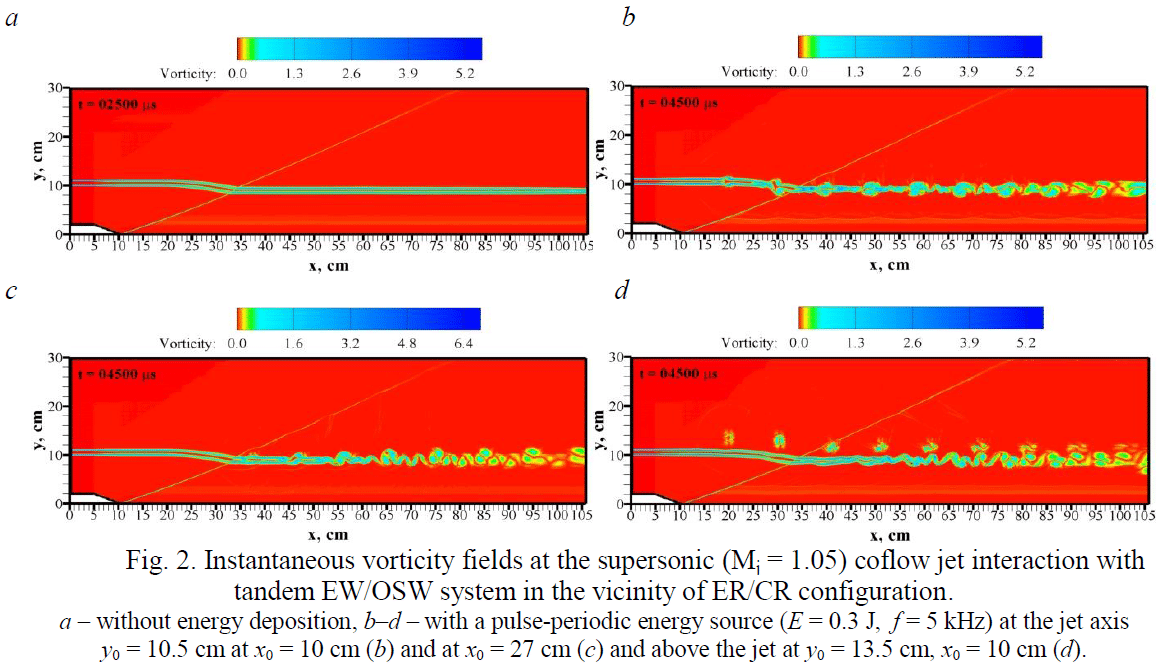Experimental and computational researches of supersonic mixing control with using various devices are reviewed. The perspective of using a localized pulse-periodic energy supply, which in practice could be realized by means of electrical, optical, or microwave discharges, to enhance the supersonic mixing of compressible shear layers downstream of tandem oblique shock wave (OSW) and expansion waves (EW) systems are demonstrated in conditions of incident the Mach number М∞ = 2.0 flow over 20-deg compression/expansion (CER) and expansion/compression ramps (ECR) configurations.
The study was done on a basis of numerical computations within the framework of 2-D unsteady Euler equations for an ideal perfect gas. The equations were solved using the Godunov-type finite volume scheme of third order of accuracy in space. Time integration was carried out using the explicit third-order TVD Runge–Kutta method. The applicability of such approach for solving similar problems with the localized energy sources in quiescent air and in supersonic flows with the normal shock waves was validated in [1, 2].
Considered calculations were performed for 2-D isobaric co-flowing supersonic (Мj = 1.05) and subsonic (Мj = 0.7) jets of a light gas (ρj/ρ∞ = 0.5) propagating through tandem OSW/EW or EW/OSW systems arising, respectively, around CER or ECR configurations. The jets initial thickness was set equal to hj = 1 cm and the axis was located at ordinate yj0 = 10.5 cm. We used pulse-periodic energy source with an elliptic section (horizontal and vertical semiaxes, respectively, Δx = 0.5 cm and Δy = 0.25 cm) with different positions of its center (x0, y0), varying frequency f = 5 - 20 kHz and the energy supplied by a pulse E = 0.003 - 0.3 J.
Predicted vorticity flowfields shown in Fig. 1 demonstrate substantial intensification of the mixing for co-flowing supersonic jet stimulated by a localized pulse-periodic energy source with f = 5 kHz and E = 0.3 J located upstream OSW. It is seen (Figs. 1, b-d), that the density discontinuities initiated by the pulse-periodic energy source on the jet axis and above it generate the large-scale coherent vortex structures due to development of Richtmyer–Meshkov (R–M) instability. Arising the vortexes significantly enhance the mixing of the jet with surrounding supersonic flow as compared with initial situation without energy supply (Fig. 1, a). As was shown, the mixing enhancing persists even at considered lower energy rates, different frequencies and different locations of the energy source.

The computations performed for the same supersonic jet and energy source located upstream tandem EW/OSW system are shown in Fig. 2. It is seen that energy deposition leads to much lower mixing enhancement due to preliminary EW influence. Nevertheless, appearing downstream small-scale vortexes may also be considered as a sign of positive trend in mixing improvement. Performed additional calculations for subsonic coflowing jet in described conditions have demonstrated qualitatively similar peculiarities of flows for CER and ECR cases. Observed some important differences in the flowfield structures will be discussed.

REFERENCES
- Zheltovodov A.A., Pimonov E.A. Numerical simulation of an energy deposition zone in quiescent air and in a supersonic flow under the conditions of interaction with a normal shock // Technical Physics. 2013. Vol. 58. № 2. P. 170–184.
- Schülein E., Zheltovodov A.A., Pimonov E.A., Loginov M.S. Experimental and numerical modeling of the bow shock interaction with pulse-heated air bubbles // Intern. J. of Aerospace Innovations. 2010. Vol. 2. № 3. P. 165–187.
- Zheltovodov A.A., Pimonov E.A. Intensification of mixing of parallel compressible flows using a localized pulse- periodic energy supply // Technical Physics Letters. 2013. Vol. 13. № 11. P. 1016–1018.

